The Vehicle Cargo Box Market is estimated to be valued at USD 2.6 billion in 2025 and is projected to reach USD 3.9 billion by 2035, registering a compound annual growth rate (CAGR) of 4.1% over the forecast period.
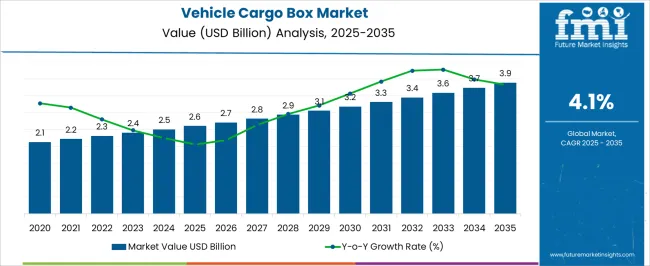
| Metric | Value |
|---|---|
| Vehicle Cargo Box Market Estimated Value in (2025 E) | USD 2.6 billion |
| Vehicle Cargo Box Market Forecast Value in (2035 F) | USD 3.9 billion |
| Forecast CAGR (2025 to 2035) | 4.1% |
The Vehicle Cargo Box market is experiencing robust growth due to increasing demand for versatile storage solutions in passenger and commercial vehicles. The current market is driven by a need for enhanced cargo capacity and vehicle customization that supports both personal and professional usage. Rising adoption of outdoor recreational activities, logistics transport, and e-commerce deliveries has emphasized the requirement for flexible and high-capacity storage systems.
Technological advancements in materials, design, and aerodynamic efficiency have further strengthened market adoption by improving fuel efficiency, durability, and overall user convenience. As vehicle ownership rises globally and consumers seek multifunctional mobility solutions, the Vehicle Cargo Box market is projected to continue its upward trajectory.
Future growth opportunities are expected to be driven by innovations in lightweight materials, modular cargo designs, and integration with vehicle safety systems, allowing end-users to optimize space utilization without compromising vehicle performance The market outlook remains promising, supported by evolving consumer preferences and increasing investment in vehicle accessories.
The vehicle cargo box market is segmented by size, length, cross-bar attachment, and geographic regions. By size, vehicle cargo box market is divided into 12-18 Cubic Feet, Less Than 12 Cubic Feet, and Greater Than 18 Cubic Feet. In terms of length, vehicle cargo box market is classified into Short Vehicle Cargo Box and Long Punch Vehicle Cargo Box. Based on cross-bar attachment, vehicle cargo box market is segmented into Aerodynamic, Round, and Square. Regionally, the vehicle cargo box industry is classified into North America, Latin America, Western Europe, Eastern Europe, Balkan & Baltic Countries, Russia & Belarus, Central Asia, East Asia, South Asia & Pacific, and the Middle East & Africa.
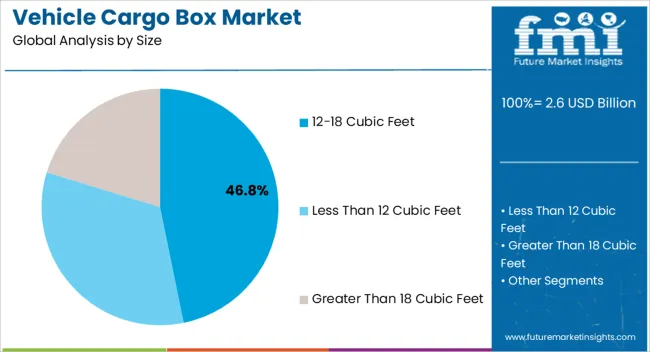
The 12-18 Cubic Feet size segment is anticipated to hold 46.80% of the overall Vehicle Cargo Box market revenue in 2025, establishing it as the leading size category. Growth in this segment has been supported by its balance between ample storage capacity and ease of installation on a variety of vehicle types. The segment has been widely adopted for personal and commercial applications, where users seek sufficient cargo space without compromising vehicle handling or aerodynamics.
Demand has been strengthened by rising interest in outdoor and recreational activities requiring moderate to high storage volume. Additionally, manufacturers have emphasized durability, lightweight construction, and compatibility with multiple vehicle models, which has accelerated adoption.
The ability to integrate this size range into existing vehicle profiles with minimal modifications has provided flexibility for consumers As urbanization, recreational travel, and logistics transport continue to expand, the 12-18 Cubic Feet segment is expected to sustain its leadership through a combination of functionality, convenience, and cost efficiency.
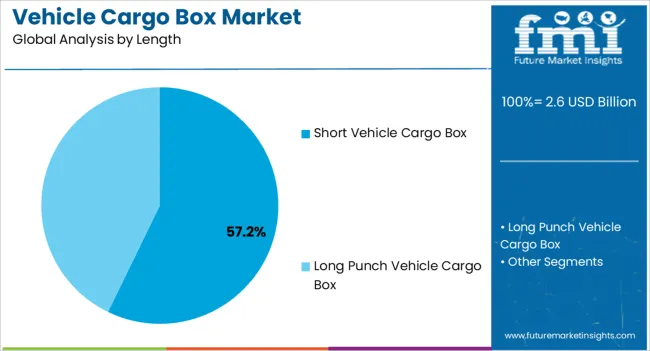
The Short Vehicle Cargo Box segment is expected to achieve 57.20% of the market share in 2025, reflecting its position as the leading length category. The growth in this segment has been influenced by its compatibility with compact and mid-sized vehicles, providing enhanced storage without affecting vehicle maneuverability. Short vehicle cargo boxes are preferred in urban and suburban regions, where limited parking space and narrow roads demand smaller vehicle accessories.
Their adoption has been further encouraged by ease of installation, lightweight construction, and ability to maintain vehicle aesthetics. Demand has been driven by the need for efficient transportation of goods and personal equipment, particularly for users seeking a balance between storage capacity and vehicle performance.
Manufacturers have leveraged modular designs and innovative materials to enhance the segment’s versatility Continued urbanization, coupled with the growth of last-mile delivery and recreational vehicle activities, is anticipated to reinforce the prominence of short vehicle cargo boxes in the global market.
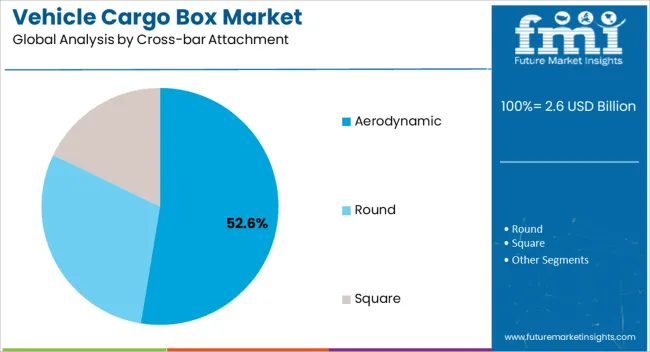
The Aerodynamic cross-bar attachment segment is projected to hold 52.60% of the Vehicle Cargo Box market revenue in 2025, establishing it as the leading attachment type. Growth has been primarily driven by increasing consumer focus on fuel efficiency, noise reduction, and vehicle stability during transit. Aerodynamic cross-bars reduce drag, minimize wind resistance, and support high-speed safety, making them preferable for long-distance and urban driving.
The segment’s adoption has been enhanced by ease of installation, structural reliability, and compatibility with various cargo box sizes and vehicle types. Rising awareness regarding vehicle performance and operational costs has further encouraged the use of aerodynamic attachments.
Additionally, manufacturers have invested in innovative designs that improve durability, corrosion resistance, and aesthetics, driving consumer preference As transportation and recreational applications expand, the aerodynamic cross-bar attachment segment is expected to maintain leadership due to its combination of functional performance, efficiency gains, and user convenience.
Vehicle cargo box is an add-on storage provision for vehicles which require extra storage capacity during traveling. Vehicle cargo box provides extra space to store luggage or any other item one wants to carry on a trip during vacation. These are more preferred by families as they are much viable to carry all the extra luggage they could, while going on long and far trips. Vehicle cargo box is durable with UV, water and scratch resistance and are usually made of ABS material.
Vehicle cargo box is designed in such a way to offer reduce wind resistance and better aerodynamic properties to reduce consumption of fuel caused by extra luggage. Vehicle cargo box is ideal for small families and people with small cars who travel often and are actively involved in outdoor camping trips and have the need to carry extra luggage. The growing urban population is also expected to drive the vehicle cargo box market in the coming years.
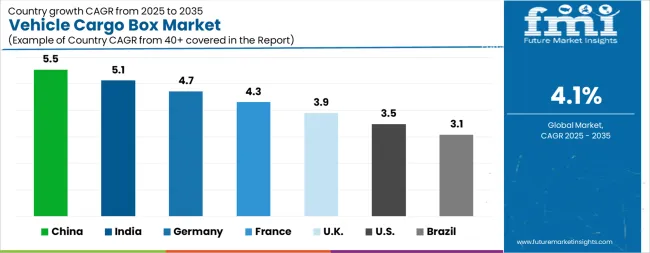
| Country | CAGR |
|---|---|
| China | 5.5% |
| India | 5.1% |
| Germany | 4.7% |
| France | 4.3% |
| U.K. | 3.9% |
| U.S. | 3.5% |
| Brazil | 3.1% |
The Vehicle Cargo Box Market is expected to register a CAGR of 4.1% during the forecast period, exhibiting varied country level momentum. China leads with the highest CAGR of 5.5%, followed by India at 5.1%. Developed markets such as Germany, France, and the U.K. continue to expand steadily, while the U.S. is likely to grow at consistent rates. Brazil posts the lowest CAGR at 3.1%, yet still underscores a broadly positive trajectory for the global Vehicle Cargo Box Market. In 2024, Germany held a dominant revenue in the Western Europe market and is expected to grow with a CAGR of 4.7%. The U.S. Vehicle Cargo Box Market is estimated to be valued at USD 948.4 million in 2025 and is anticipated to reach a valuation of USD 1.3 billion by 2035. Sales are projected to rise at a CAGR of 3.5% over the forecast period between 2025 and 2035. While Japan and South Korea markets are estimated to be valued at USD 133.4 million and USD 79.3 million respectively in 2025.

| Item | Value |
|---|---|
| Quantitative Units | USD 2.6 Billion |
| Size | 12-18 Cubic Feet, Less Than 12 Cubic Feet, and Greater Than 18 Cubic Feet |
| Length | Short Vehicle Cargo Box and Long Punch Vehicle Cargo Box |
| Cross-bar Attachment | Aerodynamic, Round, and Square |
| Regions Covered | North America, Europe, Asia-Pacific, Latin America, Middle East & Africa |
| Country Covered | United States, Canada, Germany, France, United Kingdom, China, Japan, India, Brazil, South Africa |
| Key Companies Profiled | Thule Group, AJANTA ENTERPRISE, akima, Atera GmbH, Boatbox, KüatRacks, Magna International Inc, Malone Auto Racks, Rhino-Rack USA, RoofBag, SportRack, and Yakima |
The global vehicle cargo box market is estimated to be valued at USD 2.6 billion in 2025.
The market size for the vehicle cargo box market is projected to reach USD 3.9 billion by 2035.
The vehicle cargo box market is expected to grow at a 4.1% CAGR between 2025 and 2035.
The key product types in vehicle cargo box market are 12-18 cubic feet, less than 12 cubic feet and greater than 18 cubic feet.
In terms of length, short vehicle cargo box segment to command 57.2% share in the vehicle cargo box market in 2025.






Our Research Products

The "Full Research Suite" delivers actionable market intel, deep dives on markets or technologies, so clients act faster, cut risk, and unlock growth.

The Leaderboard benchmarks and ranks top vendors, classifying them as Established Leaders, Leading Challengers, or Disruptors & Challengers.

Locates where complements amplify value and substitutes erode it, forecasting net impact by horizon

We deliver granular, decision-grade intel: market sizing, 5-year forecasts, pricing, adoption, usage, revenue, and operational KPIs—plus competitor tracking, regulation, and value chains—across 60 countries broadly.

Spot the shifts before they hit your P&L. We track inflection points, adoption curves, pricing moves, and ecosystem plays to show where demand is heading, why it is changing, and what to do next across high-growth markets and disruptive tech

Real-time reads of user behavior. We track shifting priorities, perceptions of today’s and next-gen services, and provider experience, then pace how fast tech moves from trial to adoption, blending buyer, consumer, and channel inputs with social signals (#WhySwitch, #UX).

Partner with our analyst team to build a custom report designed around your business priorities. From analysing market trends to assessing competitors or crafting bespoke datasets, we tailor insights to your needs.
Supplier Intelligence
Discovery & Profiling
Capacity & Footprint
Performance & Risk
Compliance & Governance
Commercial Readiness
Who Supplies Whom
Scorecards & Shortlists
Playbooks & Docs
Category Intelligence
Definition & Scope
Demand & Use Cases
Cost Drivers
Market Structure
Supply Chain Map
Trade & Policy
Operating Norms
Deliverables
Buyer Intelligence
Account Basics
Spend & Scope
Procurement Model
Vendor Requirements
Terms & Policies
Entry Strategy
Pain Points & Triggers
Outputs
Pricing Analysis
Benchmarks
Trends
Should-Cost
Indexation
Landed Cost
Commercial Terms
Deliverables
Brand Analysis
Positioning & Value Prop
Share & Presence
Customer Evidence
Go-to-Market
Digital & Reputation
Compliance & Trust
KPIs & Gaps
Outputs
Full Research Suite comprises of:
Market outlook & trends analysis
Interviews & case studies
Strategic recommendations
Vendor profiles & capabilities analysis
5-year forecasts
8 regions and 60+ country-level data splits
Market segment data splits
12 months of continuous data updates
DELIVERED AS:
PDF EXCEL ONLINE
Vehicle-Mounted Payment Terminal Market Size and Share Forecast Outlook 2025 to 2035
Vehicle Scanner Market Size and Share Forecast Outlook 2025 to 2035
Vehicle-to-grid Market Size and Share Forecast Outlook 2025 to 2035
Vehicle Transfer Case Market Size and Share Forecast Outlook 2025 to 2035
Vehicle Barrier System Market Size and Share Forecast Outlook 2025 to 2035
Vehicle Acoustic DSP Chips Market Size and Share Forecast Outlook 2025 to 2035
Vehicle Jump Starter Market Size and Share Forecast Outlook 2025 to 2035
Vehicle Moving Services Market Size and Share Forecast Outlook 2025 to 2035
Vehicle Security Sensor Market Size and Share Forecast Outlook 2025 to 2035
Vehicle To Vehicle Communication Market Size and Share Forecast Outlook 2025 to 2035
Vehicle Roadside Assistance Market Size and Share Forecast Outlook 2025 to 2035
Vehicle as a Service Market Size and Share Forecast Outlook 2025 to 2035
Vehicle Integrated Solar Panels Market Size and Share Forecast Outlook 2025 to 2035
Vehicle Networking Market Size and Share Forecast Outlook 2025 to 2035
Vehicle-to-Everything (V2X) Cybersecurity Market Size and Share Forecast Outlook 2025 to 2035
Vehicle Armor Market Size and Share Forecast Outlook 2025 to 2035
Vehicle Conversion Market Size and Share Forecast Outlook 2025 to 2035
Vehicle Health Monitoring Market Size and Share Forecast Outlook 2025 to 2035
Vehicle Tracking System Market Size and Share Forecast Outlook 2025 to 2035
Vehicle Radar Test System Market Size and Share Forecast Outlook 2025 to 2035

Thank you!
You will receive an email from our Business Development Manager. Please be sure to check your SPAM/JUNK folder too.
Chat With
MaRIA